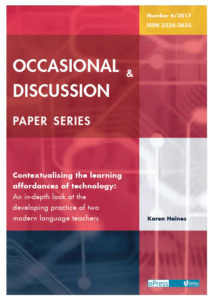 Affordance is an integral part of the practical knowledge teachers acquires while using new technologies in their teaching. This article describes the situated learning of two experienced modern language teachers using new technologies as they learned to perceive and implement learning affordances of several new tools in their individual classroom contexts, including Second Life and Wimba. The teachers identified and actualised learning affordances that allowed them to support students’ learning according to their respective beliefs about teaching and learning. The implications for computer-assisted language learning (CALL) teacher development are discussed in relation to professional learning and to the enriching of effective teaching practice.
Affordance is an integral part of the practical knowledge teachers acquires while using new technologies in their teaching. This article describes the situated learning of two experienced modern language teachers using new technologies as they learned to perceive and implement learning affordances of several new tools in their individual classroom contexts, including Second Life and Wimba. The teachers identified and actualised learning affordances that allowed them to support students’ learning according to their respective beliefs about teaching and learning. The implications for computer-assisted language learning (CALL) teacher development are discussed in relation to professional learning and to the enriching of effective teaching practice.